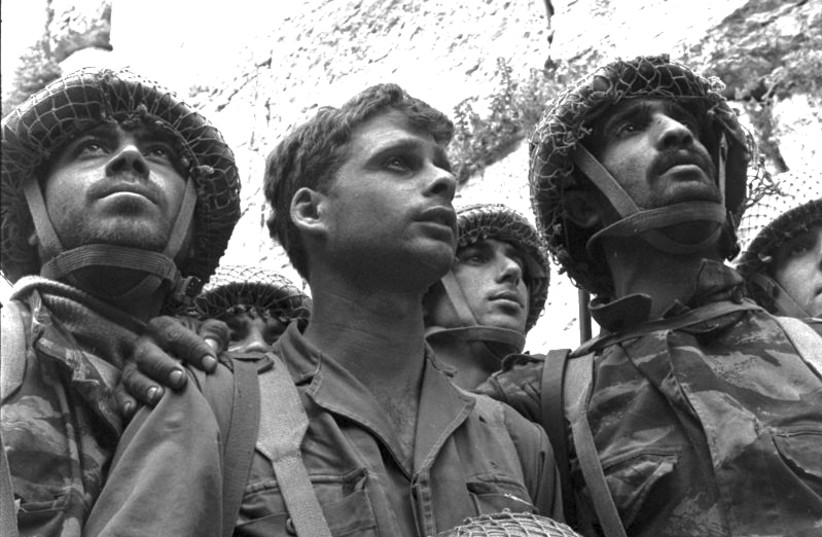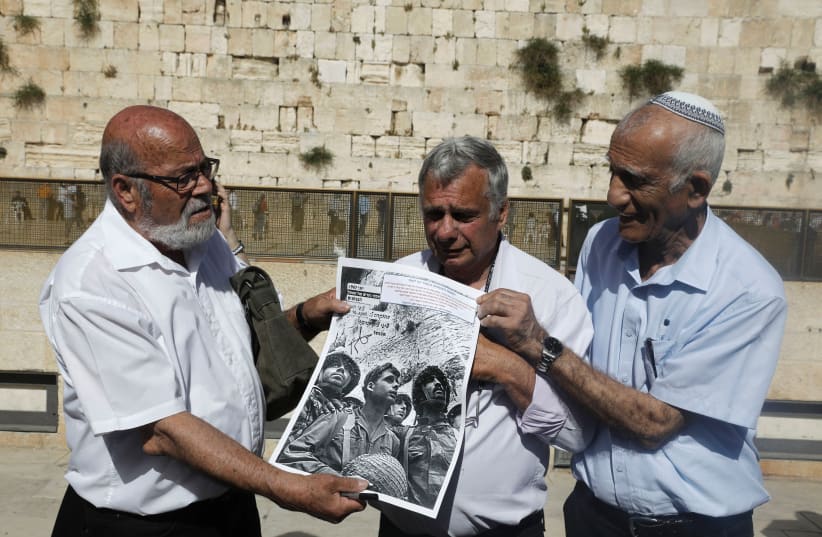This article originally appeared in 1987, to mark the 20th anniversary of the Six Day War.
Yitzhak Yifat doesn’t remember taking off his helmet seconds after his Paratroopers Brigade captured the Western Wall in the 1967 Six Day War. He barely recalls a fellow soldier sharing the moment by clasping his shoulder. And he certainly doesn’t recollect a photographer snapping a picture of him as he stared up at the holy site.
That scene, however, made history. Yifat’s awestruck expression reflected the fledgling Israeli nation’s own euphoria over the reunification of Jerusalem under Jewish sovereignty for the first time in 2,000 years.
For more stories released for the 55th anniversary of the Six Day War, click here.
The photograph appeared throughout the country – in newspapers, on posters and later in books about the war. Yifat suddenly had become more than a soldier who participated in an extraordinary event. He became the symbol of hope for a nation and a people.
On the eve of the 20th anniversary of the war, Yifat, now a gynecologist, sat in his Rishon Lezion apartment studying furiously for an examination. He took a break from underlining his obstetrics textbook to speak at length about the war and the iconic photograph.


Though overwhelmed at the time by a sense of history, Yifat was less than euphoric. His battalion had suffered many losses, and some of his closest friends had died in the battle for Jerusalem. While the Six Day War was won swiftly, and the victory for Israel equated with a modern-day miracle, Yifat’s own attitude was far more sober.
“I really wonder if all of those people had to die for a miracle,” said Yifat, who was 24 years old and a reserve soldier when the war broke out.
Yifat was recognized almost everywhere he went, and he noted that the photograph “has not given me any rest since,” disrupting his life immensely. Now married and a father of three daughters, Yifat is still stopped on the street and identified as the soldier who liberated the Old City.
“But I don’t feel that I personally liberated Jerusalem,” he said. “I was just a part of a chain.”
“But I don’t feel that I personally liberated Jerusalem. I was just a part of a chain.”
Yitzhak Yifat
What he felt, as he stared up at the Western Wall for the first time, was a sense of seeing all of Israel’s history passing before his eyes.
“I saw Roman cavalrymen trampling people. I saw the war of the Maccabees, the concentration camps, and the 1948 War of Independence when supplies couldn’t reach Jerusalem. I saw all of these things in my imagination,” he recalled.
The battle
HIS UNIT was one of the last to be mobilized for reserve duty in the weeks preceding the war. When the fighting began, the battalion headed south for battle in Sinai. But halfway there, they were instead ordered to go to Jerusalem.
“We got our orders on very short notice. We didn’t know the area. I knew El Arish better than Jerusalem,” recalled Yifat, who was born and raised in Tel Aviv.
After a bloody battle at Jerusalem’s Ammunition Hill, the paratroopers reached Mount Scopus. From there, they proceeded to the Lion’s Gate, where they entered the Old City and reclaimed the Western Wall.
Yifat remarked that when he first saw the photograph, which was taken by photojournalist David Rubinger, he said to himself, “How did I get there?”
The picture also crept up on Rubinger, who was photographing the war for the IDF as well as for Life magazine.
“I took the picture lying down on the floor, so I could photograph the troops with the Western Wall in the background,” he explained.
At the time, Rubinger thought his best shot was of then-chief army Rabbi Shlomo Goren blowing the shofar at the site minutes after it came into Israeli hands. It was only after he had developed his film that it became apparent that the scene of Yifat and his comrades was far more powerful.
“Actually, it was my wife who said that the ‘guy with the helmet’ was more impressive,” admitted the 63-year-old Rubinger, who came to Israel in 1939 from Vienna.
“If any photographer in his lifetime shoots a photo that is so famous and widely seen, he should be very, very happy,” he reflected. “To ask for more would be frivolous.”
To Yifat’s chagrin, the photograph has also become a symbol that others have eagerly tried to exploit. At one point, a cigarette company used the picture in its advertisements. Yifat said he was extremely upset when a political movement printed the photograph in its campaign material. Another time, an Israeli newspaper reporter wrote an inaccurate story claiming that Yifat and his family had left the country.
TODAY, YIFAT is deeply disappointed with the “commercialization” of the Western Wall, noting that secular Jews such as himself have ceased feeling comfortable there.
Noted Rubinger: “We missed the opportunity to make it a wall of peace. That is a great misfortune.”
While Rubinger’s historic photograph was the cause of Yifat’s unexpected fame, the two have never met.
And despite the fact that the walls of Yifat’s own home are covered with paintings and drawings, the doctor does not own a copy of the photograph that captivated the imagination of millions of Jews around the world.
“We don’t need a photograph,” said Yifat’s wife, Hasia, as she glanced affectionately over at him. “We have the original.” ■
